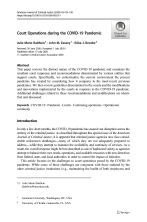By Amy J. Schmtz and Cynthia Alkon
This article explores the potential of technology to improve access to justice (A2J) in criminal courts, specifically for nonviolent misdemeanor cases. Despite a push for innovation in courts, criminal courts have been slow to embrace change and technological innovation due to factors like constitutional constraints and funding limitations. This article argues that criminal courts need "virtual windows" alongside traditional "brick and mortar doors" to enhance A2J. It proposes a problem-solving approach focusing on misdemeanor cases, a high-volume category where technology can have a significant impact. The paper highlights the importance of ensuring defendants make "knowing and intelligent" pleas despite the often-real consequences of misdemeanor convictions. The analysis also proposes a "green light, yellow light, red light" framework to categorize technologies based on their potential to improve A2J vs. the dangers they pose for defendants. Notably, the article acknowledges the digital divide but argues that the increasing prevalence of mobile devices and internet access necessitates exploring technological solutions for lowering barriers to justice. The paper concludes by calling for the adoption of "green light" technologies to improve A2J in misdemeanor cases, while acknowledging the need for thoughtful implementation to avoid unintended consequences. It also suggests further research with respect to “yellow light” ideas that may be worth further exploration with an aim toward furthering fairness and A2J.
25 Cardozo Journal of Conflict Resolution 177-228 (2024)
Ohio State Legal Studies Research Paper No. 854





















